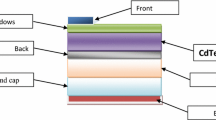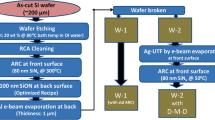Abstract
Mono c-Si solar cells based on plasmonic anti-reflector, an ultra-thin silver (Ag) film sandwiched between silicon nitride (SiNx) layers on non-textured c-Si surface, have been explored. Prior to solar cell fabrication, the plasmonic anti-reflector structure was optimized separately by varying different thicknesses of top and bottom SiNx layers and the sandwiched ultra-thin Ag film. For broad wavelength range (300–1200 nm), minimum weighted reflectance was observed in the range of 8–9 %, for the top and bottom SiNx layers having 70–80-nm thickness. The refractive index of top and bottom SiNx layers was in the range of 1.77–1.80 and 1.92–1.96, respectively. A 180-μm non-textured mono c-Si solar cell is fabricated with plasmonic anti-reflector, having top and bottom SiNx layer thickness of 80-nm and 8–9-nm sandwiched ultra-thin Ag layer, resulted in 17 % solar cell efficiency. The measured efficiency was 1.8 % higher compared to 180-μm mono c-Si solar cell with standard 80 nm SiNx anti-reflector. The short circuit current density (J sc) extracted from external quantum efficiency (EQE) has shown 0.5 mA/cm2 enhancement for the dielectric–metal–dielectric (D-M-D) sandwiched structure (plasmonic anti-reflector)-based solar cell compared to standard SiNx anti-reflection coating (ARC) structure-based solar cell. EQE enhancement was seen for all wavelengths above 700 nm with maximum 25–26 % enhancement at around 1125 nm. Also, in UV wavelength region (300–400 nm), EQE enhancement was seen with maximum 25 % enhancement at around 370 nm. Possible phenomenon for improved anti-reflection and EQE in D-M-D-based plasmonic anti-reflector has been discussed.














Similar content being viewed by others
References
www.itrpv.net/Reports/Downloads/2014/ (2014) International Technology Roadmap for Photovoltaic (ITRPV) 2013 Results, 1–37
Jain S, Depauw V, Miljkovic VD et al (2014) Broadband absorption enhancement in ultra-thin crystalline Si solar cells by incorporating metallic and dielectric nanostructures in the back reflector. Prog Photovolt Res Appl. doi:10.1002/pip.2533
Martini R, Kepa J, Debucquoy M et al (2014) Thin silicon foils produced by epoxy-induced spalling of silicon for high efficiency solar cells. Appl Phys Lett 105:173906. doi:10.1063/1.4901026
Terheiden B, Ballmann T, Horbelt R et al (2015) Manufacturing 100-μm-thick silicon solar cells with efficiencies greater than 20% in a pilot production line. Phys Status Solidi 212:13–24. doi:10.1002/pssa.201431241
Teplin CW, Grover S, Chitu A et al (2014) Comparison of thin epitaxial film silicon photovoltaics fabricated on monocrystalline and polycrystalline seed layers on glass. Prog Photovolt Res Appl. doi:10.1002/pip.2505
Ghannam M, Sivoththaman S, Poortmans J et al (1997) Trends in industrial silicon solar cell processes. Sol Energy 59:101–110. doi:10.1016/S0038-092X(96)00095-3
Atwater HA, Polman A (2010) Plasmonics for improved photovoltaic devices. Nat Mater 9:205–213. doi:10.1038/nmat2629
Pillai S, Catchpole KR, Trupke T, Green MA (2007) Surface plasmon enhanced silicon solar cells. J Appl Phys 101:093105. doi:10.1063/1.2734885
El Daif O, Tong L, Figeys B et al (2012) Front side plasmonic effect on thin silicon epitaxial solar cells. Sol Energy Mater Sol Cells 104:58–63. doi:10.1016/j.solmat.2012.05.009
Spinelli P, Hebbink M, de Waele R et al (2011) Optical impedance matching using coupled plasmonic nanoparticle arrays. Nano Lett 11:1760–1765. doi:10.1021/nl200321u
Fan R-H, Zhu L-H, Peng R-W et al (2013) Broadband antireflection and light-trapping enhancement of plasmonic solar cells. Phys Rev B 87:195444. doi:10.1103/PhysRevB.87.195444
Yang Y, Pillai S, Mehrvarz H et al (2012) Enhanced light trapping for high efficiency crystalline solar cells by the application of rear surface plasmons. Sol Energy Mater Sol Cells 101:217–226. doi:10.1016/j.solmat.2012.02.009
Singh HK, Sharma P, Solanki CS (2014) Broadband reflection minimization using silver ultra thin film sandwiched between silicon nitride layers for c-Si solar cell application. Plasmonics 9:1409–1416. doi:10.1007/s11468-014-9757-5
Standard IEC 60904–3 (2008) Measurement principles for terrestrial PV solar devices with reference spectral irradiance data. Int Electrochem Commun
Oates TWH, Losurdo M, Noda S, Hinrichs K (2013) The effect of atmospheric tarnishing on the optical and structural properties of silver nanoparticles. J Phys D Appl Phys 46:145308. doi:10.1088/0022-3727/46/14/145308
Saroja G, Vasu V, Nagarani N (2013) Optical studies of Ag2O thin film prepared by electron beam evaporation method. Open J Met 3:57–63. doi:10.4236/ojmetal.2013.34009
Stephan S (2014) 2/3-Diode Fit (2014) http://nanohub.org/resources/14300. In: nanoHub. http://nanohub.org/resources/14300
Suckow S, Pletzer TM, Kurz H (2014) Fast and reliable calculation of the two-diode model without simplifications. Prog Photovolt Res Appl 22:494–501. doi:10.1002/pip.2301
Robinson SJ, Aberle AG, Green MA (1994) Departures from the principle of superposition in silicon solar cells. J Appl Phys 76:7920. doi:10.1063/1.357902
Breitenstein O, Rißland S (2013) A two-diode model regarding the distributed series resistance. Sol Energy Mater Sol Cells 110:77–86. doi:10.1016/j.solmat.2012.11.021
Li Z, Xu G, Chen Y et al (2012) Improved homogeneous emitter solar cells with double layer anti-reflection coatings. Energy Procedia 27:402–405. doi:10.1016/j.egypro.2012.07.084
Kreibig U, Vollmer M (1995) Optical properties of metal clusters. Springer Series in Material Science vol 25; Berlin: Springer
Murray WA (2005) Optical properties of nanoscale silver structures fabricated by nanosphere lithography. University of Exeter, http://shannon.ex.ac.uk/research/emag/pubs/Andy_Murray_thesis.pdf
Zayats AV, Smolyaninov II, Maradudin AA (2005) Nano-optics of surface plasmon polaritons. Phys Rep 408:131–314. doi:10.1016/j.physrep.2004.11.001
Jourlin Y, Tonchev S, Tishchenko AV et al (2009) Spatially and polarization resolved plasmon mediated transmission through continuous metal films. Opt Express 17:12155–12166. doi:10.1364/OE.17.012155
Zhou L, Huang CP, Wu S et al (2010) Enhanced optical transmission through metal-dielectric multilayer gratings. Appl Phys Lett 97:1–4. doi:10.1063/1.3458702
West CS, O’Donnell KA (1995) Observations of backscattering enhancement from polaritons on a rough metal surface. J Opt Soc Am A 12:390. doi:10.1364/JOSAA.12.000390
Gu Z-H, Dummer RS, Maradudin AA, McGurn AR (1989) Experimental study of the opposition effect in the scattering of light from a randomly rough metal surface. Appl Opt 28:537. doi:10.1364/AO.28.000537
Wang W, Song M, Bae T-S et al (2014) Transparent ultrathin oxygen-doped silver electrodes for flexible organic solar cells. Adv Funct Mater 24:1551–1561. doi:10.1002/adfm.201301359
Sergeant NP, Hadipour A, Niesen B et al (2012) Design of transparent anodes for resonant cavity enhanced light harvesting in organic solar cells. Adv Mater 24:728–732. doi:10.1002/adma.201104273
Sennett RS, Scott GD (1950) The structure of evaporated metal films and their optical properties. J Opt Soc Am 40:203. doi:10.1364/JOSA.40.000203
Acknowledgments
This work was done at the “National Centre for Photovoltaic Research and Education (NCPRE), IIT-Bombay” which is financially supported by the “Ministry of New Renewable Energy (MNRE), Govt. of India.” The authors would like to acknowledge Som Mondal, Mehul Raval, Dr. S. Saravanan, and other colleagues at NCPRE for their help in fabrication and discussions. Also, the authors would like to acknowledge IIT Bombay Nanofabrication Facility (IITBNF) and the faculty members (Prof. J. Vasi, Prof. Anil, Prof. B.M. Arora, and Prof. K.L. Narasimhan) as well as the staff members for their great team work and support.
Author information
Authors and Affiliations
Corresponding author
Rights and permissions
About this article
Cite this article
Singh, H.K., Arunachalam, B., Kumbhar, S. et al. Opto-Electrical Performance Improvement of Mono c-Si Solar Cells Using Dielectric–Metal–Dielectric (D-M-D) Sandwiched Structure-Based Plasmonic Anti-Reflector. Plasmonics 11, 323–336 (2016). https://doi.org/10.1007/s11468-015-0049-5
Received:
Accepted:
Published:
Issue Date:
DOI: https://doi.org/10.1007/s11468-015-0049-5




